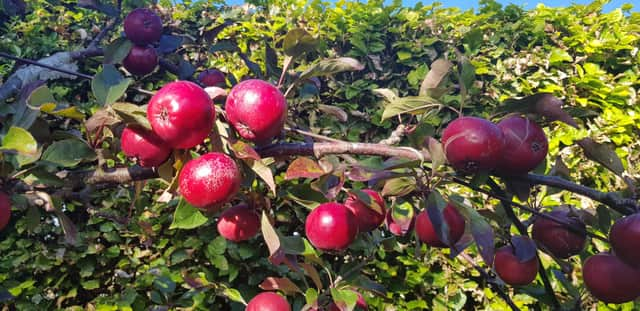GARDENING: In praise of the humble apple tree


A single tree planted in autumn can transform an outdoor area, and last for decades. No wonder one day each year (21st October 2020) is dedicated to celebrating this special fruit.
Established 30 years ago, National Apple Day has grown in stature, with activities such as talks, demonstrations, tasting and identification.
Advertisement
Hide AdAdvertisement
Hide AdAt this time of year it's not unusual for somebody to hold one in front of me and ask `Which variety is this?` Before answering I feel obliged to explain that there are circa 8,000 in existence, which means if you ate a different variety every day for twenty years, there`d still be more to taste and discover.
However, this does not entirely rule out identifying the apple in question. Accessibility and regional climatic differences limit actual choice to hundreds rather than thousands of varieties at best, and gardeners tend to choose cultivars that are reliable croppers in their area.
Even specialist nurseries have a limit to the number of varieties they can stock. Browse a fruit catalogue and you`ll find a combination of tried and tested cultivars, some heritage types, and a few newcomers. Next time you're at the local garden centre, note the total number of culinary and dessert varieties on display. It may appear limited but should comprise proven varieties that do well in the north. And no worries if the cultivar of your dreams is not on display. Just ask and they`ll hopefully order it for you.
A self-confessed malus-domestica-holic, I`ve always grown apples, and last year managed to round up twenty-one varieties for an autumn photo-call.
Advertisement
Hide AdAdvertisement
Hide AdThese included three reliable cookers; `Bramley's Seedling,` `Howgate Wonder` and `Lord Derby.` Four favourite dessert types; `Discovery,` `James Grieve,` `Egremont Russet` and `Braeburn,` completed a magnificent seven that crop so reliably. Each one, except `Bramley`s is self-fertile. It is a triploid which needs two other pollinators to secure the fruit, but happily it's companions flower at the same time.
This season's harvesting continues. Storage is in the cool but frost-free garage. The wooden stack of drawers has laths at the base and open sides, allowing a constant air flow. The apples are not wrapped but stand individually on sheets of grease-proof paper for easy inspection!
Deciduous apple trees will soon be shedding their leaves and going into dormancy. This presents an opportunity to introduce young specimens to your garden. When choosing these ascertain which type of rootstock the apple cultivar has been grafted onto, as a guide to how tall it will grow.
M27 is the most dwarfing apple rootstock. Bush trees grafted onto it will ultimately reach two metres in height. The M9 will take them over 2.5 metres, and on the M26 they will attain 3 metres. These three are most suitable for normal sized gardens but more vigorous types exist. Apple cultivars grafted onto dwarf types do start fruiting sooner than those that are more vigorous.
Advertisement
Hide AdAdvertisement
Hide AdWhen you buy an apple variety there's a choice of either container-grown or bare-rooted types. Those grown in large pots should come with a well- developed root ball that offers the best possible start. They`re more expensive than the bare rooted form which are dug from a nursery bed, carefully packaged, and delivered to your door via mail order. Get them straight into a bucket of water for a few hours then planted as soon as possible. If this is to be delayed dig a temporary spot and cover the roots with soil.
Prepare the planting site well, adding mature organic matter and a slow release fertiliser. I always pour water into the hole before the plant is introduced then backfill with soil and make it firm. Consider adding a variety for the historic interest it brings e.g. `Flower of Kent` the cooking apple that existed in 1629 and had a name change after one of its fruits fell on a young scientist`s head in 1665. You can find it under the name `Isaac Newton` in a catalogue!